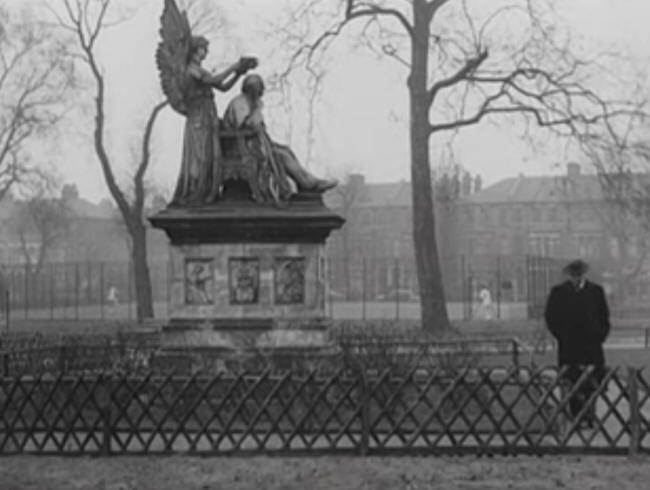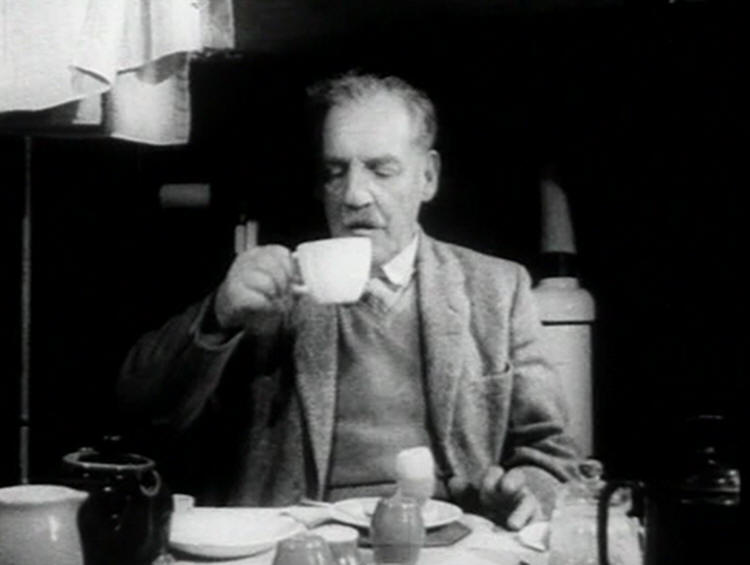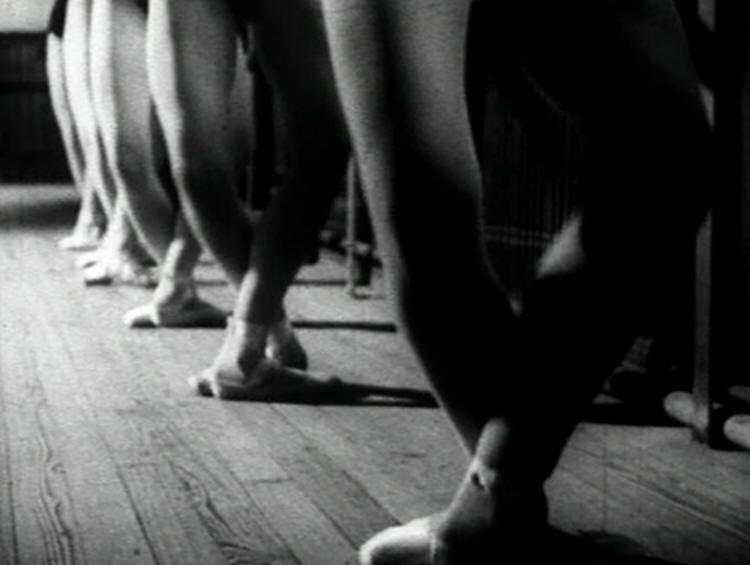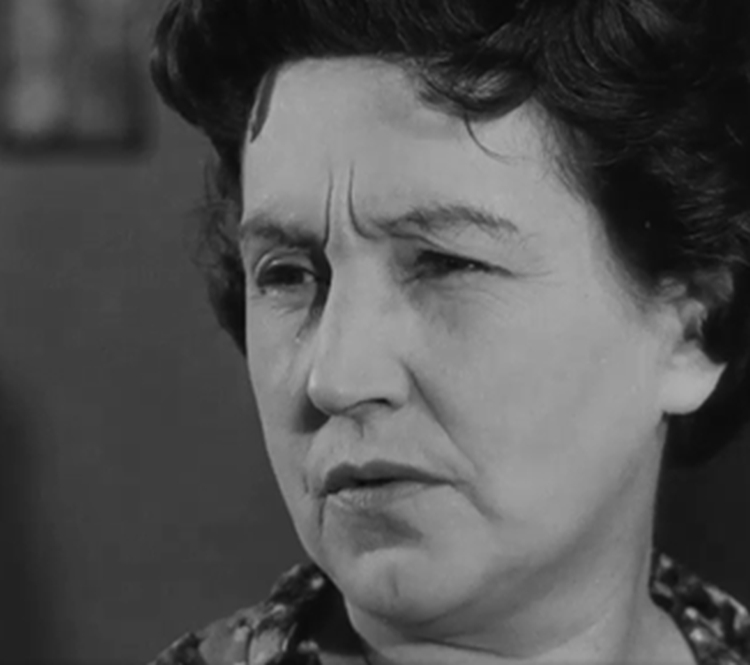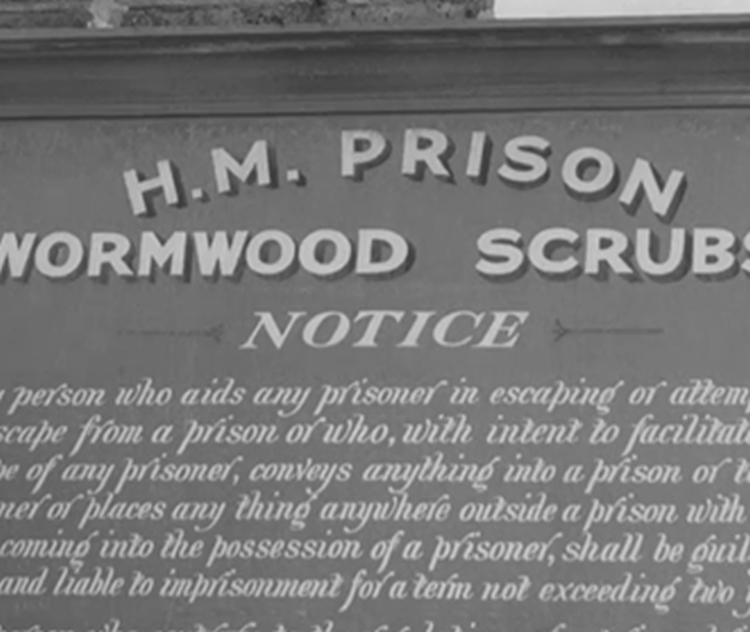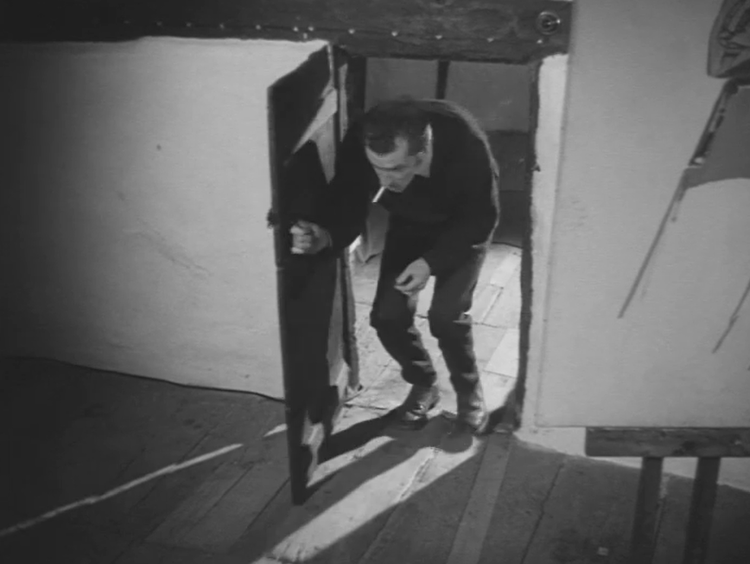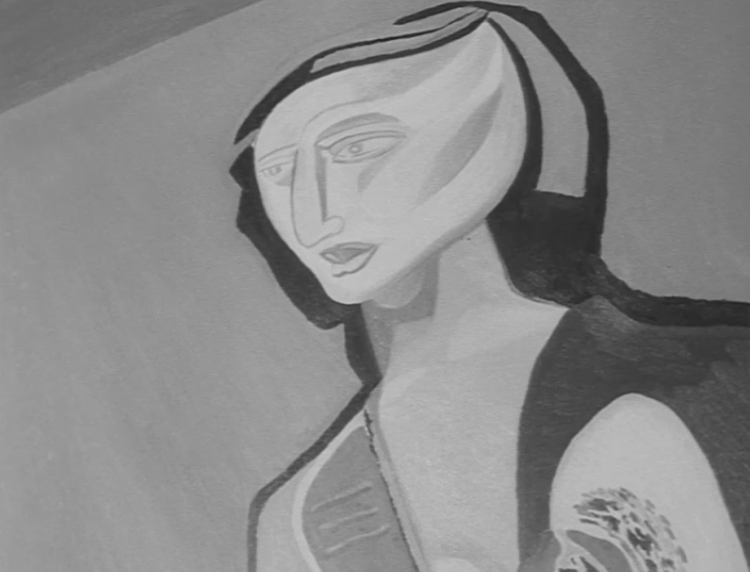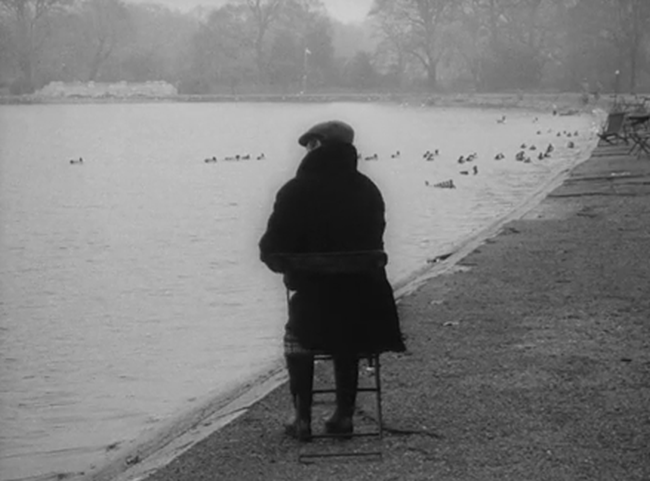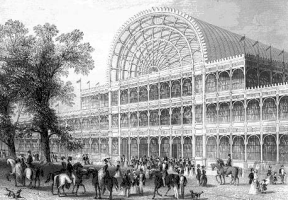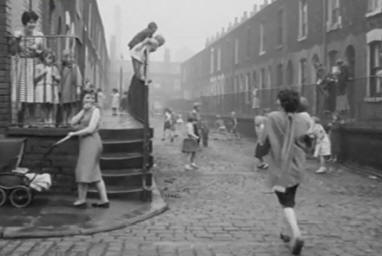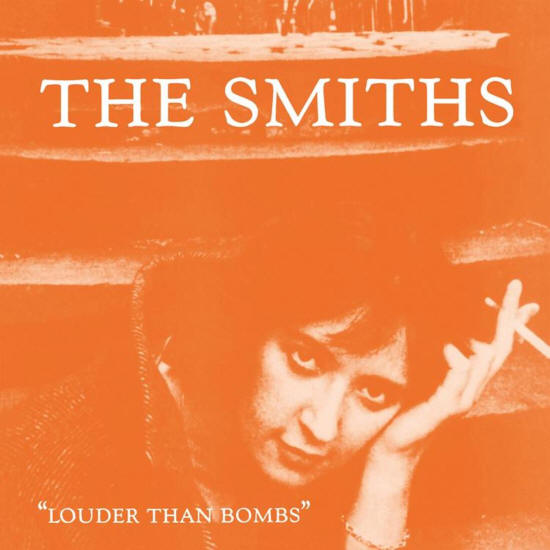Ken Russell monitor shorts
|
Monitor shorts Monitor was a BBC television series of black and white arts documentaries. Huw Wheldon ran the Monitor series and was looking for a new director to join his team. Ken Russell submitted his amateur film Amelia and the Angel and despite being a newcomer he got the job, though actually he was a contractor and was never on the full-time staff. He produced some of the best television ever made. Russell initially produced short 10-15 minute films on a range of subjects, chosen by himself but approved by Weldon. This continual stream of commissions allowed Russell to explore his ideas and develop his technical abilities. Gradually he was allowed to produce full length television films. 1956 Poets London Russell's first commission for the BBC about the poet John Betjeman. Ken Russell wanted to demonstrate his ability to Huw Wheldon, and succeeded in being hired for Monitor, though his budget hardly improved since his amateur days: £300.
Russell and Betjeman based the film around the poems Monody on the Death of Aldersgate Street Station, Business Girls, The Olympic Girl and Hertfordshire. This allowed Russell to use a string of images cut to match the poetry.
Monody has images of churches and graveyards as well as the station, now without its roof. Snow falls on the buffet of
Aldersgate Station
Business Girls shows women in Camden Town going to work along with the glorious use of steam from a train- the steam rising slowly to blank out a scene. From the geyser ventilators
Olympic Girl has Betjeman staring wistfully at posters of women, then through railings at women, before realising he is 53 and past this sort of thing, and walking away lonely. The sort of girl I like to see (the section marked () is unclear. Books of his poetry leave these few words blank).
In Hertfordshire Betjeman reflects on his childhood- painful times
when he went shooting with his father.
I had forgotten Hertfordshire, Betjeman at his best, providing the commentary as well as reading his poetry- not taking himself seriously while at the same time bringing out the beauty of the poetry. Similar in some ways to "Night Mail" it is the start at the BBC that Russell wanted. Russell said of the imagery in the film "poems are mini film scripts, you don't mirror the words but do a running commentary" (BFI talk, 29 July 2007). "Betjeman's warm relationship with Russell, a fellow maverick, was assisted by the difference in their ages, an element that erased much of the rivalry that Betjeman felt when working with his own generation" (Betjeman's England, edited by Stephen Games, 2010, pp 21-22).
One scene included actors. "Innocently he tried to include a scene with some friends of his, dressed up in Edwardian clothes. Real people were not impersonated in television documentaries in those days. Wheldon thought it cheating, and removed the scene at once" (from Sir Huge (sic) The Life of Huw Wheldon by Paul Ferris, 1990). Familiar Russell images, the steam train and a body (doll) in the water appear even this early in his career. The editor is Monitor regular Allan Tyrer. 12 minutes.
Betjeman writes in a letter to a Miss Knight of the BBC Accounts Department on 26 Feb 1959 "I am sorry you have had so much trouble to get me. I delayed agreeing a fee until I knew how much work was involved. This is now completed. It involved reciting four of my poems, visiting different parts of London one afternoon with Ken Russell, spending a morning at Aldersgate here, being filmed and speaking an introduction into the microphone. Spending an afternoon at King's Cross an Vauxhall Park, being filmed and speaking. Spending a morning going to Hatfield and being filmed there. Going to Ealing to record. And going another afternoon to Vauxhall Park and Finchley. As a self-employed person my time is my chief expense. Do you really think forty guineas is enough for what represents a good half-week's work? I do not wish to be demanding and embarrass the promoters of what I think is an interesting experiment. But if there is any money to spare I wouldn't say no to some of it" (John Betjeman Letters Volume Two: 1951-1984 edited by Candida Lycett Green). The editor notes "JB finally agreed on fifty guineas for his part in the Monitor programme for BBC television which was called A Poet in London".
A poster with the two women in pieces, a similar concept Ken used in his Aria film from 1987.
The music includes:
Michael Brooke in his excellent notes for the BFI season of Russell early films (July 2007) suggests because Ken wanted to ensure he got the job at Monitor, the film is his most conservative and less inventive. An interesting viewpoint, but I still would praise the film for bringing out the essence of Betjeman, as Ken said "inspirational and cosy" (BFI talk, 29 July 2007). All images from the film and from Aria. 1959 Gordon Jacob
A genial film with the composer Gordon Jacob living a quiet life. Each morning before breakfast he goes for a walk.
Back at home he has breakfast then works composing on the piano until lunchtime. He then has a break till tea time, then works again until suppertime.
The films covers his life including 25 years as Professor of Composition at the Royal College of Music.
During the First World War he was captured, and in the prisoner of war camp he set up an orchestra. Gordon Jacob is in the middle of the front row.
When the film moves to ballet dancers the Russell magic enters, with the feet of the dancers echoing the music. And the best scene is of the pigs: "We both loved the forest and we both loved pigs. One movement of his New Forest Suite is called ´Pannage´, which is the time of year they turn the pigs loose in the forest to forage for acorns. So there I was filming pigs going mad in the woods and cutting them to music much the same was I had cut troops running into the Basilica in the Lourdes film" (from An Appalling Talent).
Huw Wheldon introduces the programme and the commentary is by Humphrey Burton. The film editor is Allan Tyrer and producer is Peter Newington. 18 minutes. "Given that this was Russell's first composer portrait and that its successors included some of the most memorable television programmes of the 1960s, it's tempting to read too much into Gordon Jacob, but one can certainly see the green shoots of what was to become his first undisputed masterpiece, Elgar (BBC, tx. 11/11/1962) beginning to appear. At the age of thirty-one, after over a decade of considerable uncertainty over his future, Ken Russell had finally found his true vocation" (Michael Brooke, British Film Institute website, no date, click here). Composer Joseph Horovitz, a friend and former pupil of Jacob, says "He didn't look like a sort of composer or a musician, he looked more like a military man which indeed he was of course though I didn't know that. Very short, slightly greying, and very unassuming, very simple... very quietly spoken" (interviewed by Donald McLeod, Composer of the Week, BBC Radio 3, 19 April 2013). Percy A. Scholes summarises Gordon Jacob the musician "He has written piano, violin, oboe and horn concertos and other orchestral works, chamber music etc., and a manual of orchestral technique, on which he is considered an authority" (The Oxford Companion to Music, Tenth Edition). According to the tribute site "By the time Gordon Jacob died on 8 June 1984, aged 89, he had written over 700 pieces of music and several books" (https://gordonjacob.net/). "His large output includes various concertos and other orchestral works, choral music and chamber pieces, usually in a straightforward ebullient style; his music is for performers to enjoy (Paul Griffiths, Oxford Companion to Music volume 1, 1983). The music includes:
All images from the film. 1959 Guitar Crazy (also called From Spain to Streatham) Ken Russell's Guitar Crazy reflecting the craze then sweeping Britain for playing guitar.
In the opening sequence street urchins find a broken piano and hit the keys, creating their own superb music.
We see a boy practicing Hound Dog on his guitar...
... and the reaction of the mother and the goldfish to the poor guitar playing.
A guitar teacher with a student.
In Wormwood Scrubs prison inmates are taught guitar...
... which gives Russell an opportunity to include some imagery.
The film features guitarists John Williams and a sublime young Davey Graham (above) who "first acquired the status of a guitar hero in June 1959, at the age of 18, when he appeared on a Ken Russell BBC TV programme playing a complex version of Cry Me a River" (Robin Denselow, The Guardian, 17 Dec 2008, click here).
The film features some rock'n'roll guitarists anticipating the start of rock music.
The film is however marred by some racism from the time- a scene with an intelligent looking coloured boy cuts to an offensive "sambo" balloon... -this wasn't unusual for the time, but now it is a sad flaw in one of the best Monitor shorts. There is also a short homage to Some Like it Hot. 17 minutes. Introduced by Huw Wheldon and commentary by Frank Duncan. The editor was Allan Tyrer. "Also known as Guitar Craze and the more evocative
Hound Dogs and Bach Addicts, this Monitor item (Ken Russell's third for
the pioneering BBC arts strand) offers a whistle-stop tour of how Britons
are enthusiastically taking up the guitar in all sorts of ways… Russell's
lively film pays tribute to the hand-me-down nature of the skiffle
movement in the opening sequence, in which a group of children create an
impromptu band from assorted junkyard items, including a discarded piano…
The then 18-year-old Davey Graham gives a spellbinding jazz performance in
a run-down building site, attracting an understandably enthusiastic crowd
in the process. This was in fact the film that made Graham's reputation -
he would go on to become one of the leading figures in the following
decade's folk-rock revival" (Michael Brooke, BFI Screen Online, click
here). All images from the film. 1959 Variations on a Mechanical Theme Looking at a range of mechanical musical instruments from wind up organs to a musical bustle presented to Queen Victoria. Typical scenes include the organ grinder playing as the resident of a house closes his window to keep out the noise. A monkey on an organ is shown accompanied by a speech by Mussolini, and it appears Mussolini has ordered all Italian organ grinders to leave Britain, so the grinder and his monkey leave, the money looking sad. The films moves to modern times with tape recorders playing electronic music, presumably a predecessor of the BBC Radiophonic Workshop. The commentary is by Frank Duncan and written by Alex Atkinson (info from BFI film notes, Jul 2007). 13 minutes. 1959 Two Painters A Monitor short (11 minutes) about the Scottish painters Robert MacBryde and Robert Colquhoun. "Friends of Francis Bacon and Lucian Freud, they took the London art world by storm in the 1940s, with sell-out exhibitions of their paintings, but by the 1960s their position as two of the country’s most celebrated artists had been eclipsed." (National Galleries Scotland website here). When Russell worked in an art gallery, one of the exhibitions was by MacBryde and Colquhoun who he met. MacBryde "was a charming chap" and Colquhoun "looked like a cold-blooded killer from a Western". The film starts with a cart being driven down a lane and on the back of the cart are the two painters. They live in a house rented for £1 a week, and paint all day. One of the best scenes is the cart moving through foliage, beautiful images, then the camera moving slowly through the village.
The film covers Robert MacBryde first, talking about what he wants to achieve and showing him painting.
Then Robert Colquhoun is covered, seen entering a room so small he has to stoop to get in.
The films end with the same cart returning, but the back is empty, without the painters.
There are similarities with later films, Pop Goes the Easel again covers close knit painters, and the montage of paintings to music was used again at the final scene of Savage Messiah. "One of the interesting and surprising features of this short, but extremely valuable record of a small fragment of the Roberts' lives is not just in the fact that they are shown painting, giving a unique insight into their working methods, but also because they talk in some detail about their work and their motivation for producing it" (from Roger Bristow's The Last Bohemians, Sanson & Co, 2010, ch 9). John Wyver writes "This eleven-minute study of Robert MacBryde and Robert Colquhoun is a quiet and reflective tribute to the painters that offers little sense of their bohemian ways or their relationship as lovers" (John Wyver, The Filmic Fugue of Ken Russell’s Pop Goes the Easel, Journal of British cinema and television, 2015, Vol.12 4). However in 1959 homosexuality was illegal in the UK so it is not suprising Russell does not endanger them by exploring the relationship more. The programme has a short commentary and some voiceovers by each Robert, but mostly there is music including Ralph Vaughan Williams English Folk Song Suite My Bonny Boy. The music was transcribed by Gordon Jacob who was the subject of a previous Monitor short. Other music includes Frank Martin's Petite Symphonie Concertante. The commentary is by Allan McClelland, the film editor is Allan Tyrer, the producer is Peter Newington. 11 minutes. Images are from the film. The poster below is from the exhibition at the Scottish National Gallery of Modern Art. All images from the film unless otherwise credited. 1959 Portrait of a Goon A short film, 14 minutes, on Spike Milligan the comedian and member of the BBC radio series The Goons, a precursor of Monty Python. Broadcast by the BBC on 6 December 1959.
Milligan says to the camera while filming in London's Hyde Park "We have been thrown out of various parks for not having certificates by various policemen. So you can see the thing called comedy is the last thing on my mind" and "My whole outlook on comedy has been based on tragedy really, only it never becomes comic until tragedy has occurred". The film alternates these reflections by Milligan (the best part of the film) and pre-Monty Python comic sketches which have dated badly.
A shorter nine minute version is available on Internet, and excludes "The comedian Spike Milligan tells a surreal story about an altercation with a park keeper in Holland Park who accosted Milligan and his producer when they were filming. He then sings a comic song in front of a montage of war, riots, bombing and high-level international political debate, culminating in a nuclear explosion" (summary of scene from BFI Screenonline here).
Russell later wanted Milligan to play a role in The Devils (from Spike: An Intimate Memoir by
Norma Farnes, 2004). All images from the film. 1960 Marie Rambert Remembers His first film about a dancer- Marie Rambert who founded Ballet Rambert (now Rambert Dance Company). The editor was Allan Tyrer, photography was by John McGlashan. Huw Wheldon does the commentary and also interviews Marie Rambert- at times he draws out Marie Rambert but there is no real insights into her character- she preserves her inner self, he does not probe. 1960 Architecture of Entertainment/ Journey into a Lost World
Another film with the poet John Betjeman. Betjeman looks at sites of entertainment in the past from the Festival of Britain to the National Film Theatre (which is where I saw it!). There is nostalgia for the past as well as insights such as film of the entertainment centres such as ice rinks turned into hospitals in the war- crammed with beds. The film is at its most stunning when Betjeman goes to the site of Crystal Palace where there is a park with model dinosaurs and snakes. Betjeman goes by boat and seems like an unlikely Indiana Jones going through the mist and bushes to confronted with the demons. The producer is Peter Newington, the editor is Allan Tyrer and Betjeman provides the commentary. 22 minutes.
All images from the film. 1960 Cranks at Work
Another dance film, this time on John Cranko. This film is the only one of Ken's Monitor films to be lost. The Radio Times gives the broadcast date as 24 Apr 1960 and describes it as "John Cranko choreographer and revue-writer talking about his work directing dancers and rehearsing a new revue" (from BBC Genome archive here). Any further info is welcome. The image is of John Cranko but is not from the film. 1960 The Miners´ Picnic
The Miner's Picnic, also called The Bedlington Miners’ Picnic. Brass bands from the coal-mines. John Gibson, one of the miners who plays in one of the brass bands, introduces the film and gives the commentary. Russell portrays the musicians with fingers scarred and grained from work down the mines. A film of humour and compassion. The early Ken Russell had the social conscience of a Ken Loach. When Russell later filmed Women in Love he went back to film the mines and the bands. The mines were closed and the bands had stopped playing music. John McGlashan and Alan Pearce are the cameramen. 16 minutes.  All images from the film.
Shelagh Delaney's Salford broadcast on 25 Sept 1960. The writer Shelagh Delaney aged 18 wrote the play A Taste of Honey in 1958, one of the National Theatre's 100 plays of the century. Huw Weldon introduces but Shelagh gives the commentary throughout.
"Her play was innovative in breaking several taboos discreetly observed by the likes of Noël Coward and Terence Rattigan, in whose dramas working-class characters generally appeared as chirpy subsidiaries and who mostly presented women as either madonnas or sluts. A Taste of Honey showed working-class women from a working-class woman's point of view, had a gay man as a central and sympathetic figure, and a black character who was neither idealised nor a racial stereotype" (Dennis Barker, The Guardian, 21 Nov 2011 click here).
Ken Russell took Delaney back to her home town. It was filmed as her second play was about to be released. Delaney brings out the joyful aspects of her home town Salford, but also how it is slowly disappearing.
Good scenes include lots of children playing, and the camera wandering through the crowds of a marketplace.
Here Shelagh criticises the high rise flats being built without any amenities such as theatres, and so destroying communities. I like Delaney's ambivalent comment "down by the river it is romantic if you can stand the smell". Along with The Miners Picnic it shows compassion by Russell, reminiscent of early Ken Loach. The editing is by Russell regular Allan Tyrer and camerawork by Tony Leggo. The music Seven Eleven by The Temperance Seven is used well. 15 minutes.
The Smith's album Louder Than Bombs has a photo of Delaney as cover. There is a Shelagh Delaney House named after her which is "an emergency accommodation project for young homeless men and women aged 16-21 who are unable to live at home for any reason". You can donate on the SHAP website, click here. All images from the film unless otherwise credited. 1960 A House in Bayswater/ Mrs Stirling of Old Battersea House
Russell films the inhabitants of a house in London. Russell himself had lived there once. The inhabitants include dancers, a painter and a photographer. The artists are a bit pretentious, but the elderly lady who looks after the pigeon and remembers her time in America is touching. The films ends with the house being demolished to be replaced by a modern block. The 30 minute film wasn't for Monitor but for the BBC Film Department, as Monitor was between series. This was his first full length programme for the BBC.
All images from the film. 1960 The Light Fantastic Just as he had filmed the guitar craze, Russell now covered a dance craze in Britain. The film starts with market worker Ron Hitchins who transforms himself into a flamenco dancer and conveys his passion for dance. He then provides the voice over for the rest of the film, which covers a wide variety of dance styles including a group of male Latin dancers air-dancing without female partners. Allan Tyrer edits and the director of photography is Tony Leggo. 23 minutes. 1961 Antonio Gaudi
The elderly Antonio Gaudi. Ken Russell's film about the Spanish architect. Huw Wheldon gives the commentary and it is a reasonable documentary with good photography of his buildings. There are interesting facts mentioned- Gaudi's hatred of flying buttresses, and that all his building were merely experiments for his cathedral. But it lacks any bite or excitement. 15 minutes.
Gaudi's quirky interiors.
The nunnery and Russell often uses a figure in the image to make the image more personal.
Giving a sense of scale by the nun walking down the corridor towards the camera.
The stone formations which may have influenced Gaudi.
Gaudi put crosses above most of his buildings.
Gaudi's masterpiece the unfinished Sagrada Familia Cathedrail seen from another Gaudi building. Compare Ken's image (left) with the same view from a film by Hiroshi Teshigahara (right). The later film has the advantage of colour, modern cameras and (I presume) a bigger budget, but it makes little use of the building in the foreground. Ken's film brings out the beauty and uniqueness of both buildings with a typically well composed shot.
Huw Wheldon narrates. The music includes:
All images from the film plus the colour image from the film by Hiroshi Teshigahara. 1961 London Moods A disappointing film. There is no dialogue or commentary, rather music and images combine to evoke London. But there is little depth and the images or film chosen is poor, often simply postcards. Compare with his later Planets. 10 minutes.
All images from the film. 1962 Lotte Lenya Sings Kurt Weill Lenya sings songs by Kurt Weill her husband, the composer who worked with Bertolt Brecht- Mack the Knife, Pirate Jenny, Sarabaya Johnny and Alabama Song. Huw Wheldon introduces each song, then Lenya sings. Sometimes she is singing against a background of Nazi power, in others she is in a bedroom. Russell says "it was in the early 60s that I met the legendary Lenya herself and was able to talk her into appearing on the BBC Arts programme Monitor. I staged four numbers for her, including Surabaya Johnny and The Alabama Song of which I still have dazzling memories" (from programme notes of Weill and Lenya, New |End Theatre, 1999). Huw Wheldon says the film shows the first ever performances from Mahagonny in Great Britain. The film is of interest in capturing Lotte Lenya singing, but it is disappointing with little imagery or inventiveness. The editor is Allan Tyrer. 16 minutes.
Lenya would later appear in From Russia with Love with Sean Connery, just as Ken Russell later appeared with Sean Connery in The Russia House. Russell later directed a play about Lenya and Weill. The play is written by and stars Judith Paris and marks the centenary of Weill's birth.
1961 Old Battersea House The Pre-Raphaelite museum. Russell says: People are always saying my films are bizarre but they pale beside reality...she was ninety-nine then, dripping with white furs and jewels, and wearing an enormous hat. She could only walk with two sticks, and the place was so dark a servant followed her around with a lamp. She said...´my sister was at work on this painting of Azrael and the Angel of Death when a frog hopped in and looked at it and hopped out again´. Russell would also make Dante's Inferno about the Pre-Raphaelite painter Dante Gabriel Rosetti.
|
More television







